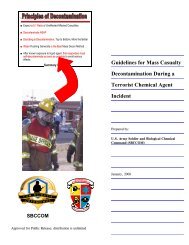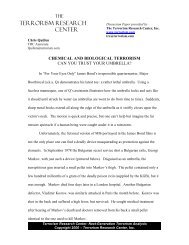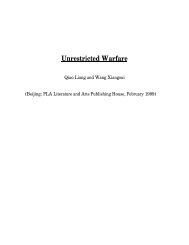Combating Proliferation of Weapons of Mass Destruction
Combating Proliferation of Weapons of Mass Destruction
Combating Proliferation of Weapons of Mass Destruction
Create successful ePaper yourself
Turn your PDF publications into a flip-book with our unique Google optimized e-Paper software.
Of these areas, research and development is <strong>of</strong> most interest to the Commission. NIH’sbasic research on infectious diseases, immunology, and microbiology is being expandedto address the biological weapons (BW) and chemical weapons (CW) threat. Thisexpansion is useful to military efforts to combat WMD. HHS has asked the Institute <strong>of</strong>Medicine (IOM), in collaboration with the Commission on Life Sciences, to review existingresearch, development, and technology on detecting chemical and biological agents aswell as on protecting and treating casualties and health care providers. Based on theresults <strong>of</strong> this review, IOM recommended and prioritized research and developmentneeded to address shortfalls in addressing the BW and CW threats. 19 In addition, NIH isplacing major emphasis on generating genetic information about potential bioterrorismagents, especially organisms that cause anthrax, tularemia, and plague—each a threat toU.S. military forces abroad. Also, both the Department <strong>of</strong> Defense (DoD) and HHS areworking on the anthrax and smallpox vaccination problems. Recognizing the militarysignificance <strong>of</strong> much <strong>of</strong> its research and development, NIH has collaborated with the U.S.Army Medical Research Institute <strong>of</strong> Infectious Diseases (USAMRIID), 20 other DoDelements, and the Department <strong>of</strong> Energy.HHS regulates shipments <strong>of</strong> certain hazardous biological organisms and toxins. Since1997, the CDC has regulated transfer <strong>of</strong> particular biological agents, established a registry<strong>of</strong> laboratories handling such materials, and ensured compliance with requirementsgoverning shipment <strong>of</strong> these materials. 21 Finally, HHS is involved in efforts by the State andDefense Departments to convert biological warfare facilities in the former Soviet Union(FSU) to legitimate pharmaceutical factories.HHS has significant resources available to combat the proliferation <strong>of</strong> WMD abroad. Asample list <strong>of</strong> funding for specific HHS activities includes:• Smallpox and anthrax vaccination R&D ($30 million in fiscal year 2000).• Vaccines, antibiotic/antiviral basic research ($22.1 million in fiscal year 2000).• An FDA-expedited review that can help speed procurement <strong>of</strong> vaccines and othertreatments for military personnel ($12.4 million in fiscal year 2000).• A public health service information technology network that can be useful to themilitary’s battlefield situation awareness capability ($40 million in fiscal year 2000).19“Chemical and Biological Terrorism, Research and Development to Improve Civilian MedicalResponse,” Committee on R&D Needs for Improving Civilian Medical Response to Chemical andBiological Terrorism Incidents, Health Science Policy Program, Institute <strong>of</strong> Medicine and Board onEnvironmental Studies and Toxicology, Commission on Life Sciences, National Research Council,National Academy Press, Washington, D.C. 1999, pre-publication copy, available at http://www.nap.edu20USAMRIID is roughly the military counterpart to the CDC and the NIH.2142 C.F.R. 72.690







